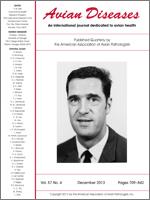Paramyxoviruses and avian influenza viruses are present worldwide, and wild birds are known natural reservoirs of these viruses. This study monitored the circulation of these viruses in migratory and resident coastal birds captured in the state of Rio de Janeiro, Brazil. In total, 494 birds were trapped, and their fecal samples were collected and inoculated into embryonated chicken eggs. The allantoic fluids were evaluated using a hemagglutination test and PCR amplification of the genes of the M and L proteins of influenza A virus and paramyxovirus, respectively. Avian paramyxovirus was detected in 5 (1.01%) of the birds. The majority of these viruses were isolated from migratory birds classified into the order Charadriiformes (families Scolopacidae and Charadriidae). Four samples were characterized as avian paramyxovirus serotype-2 (APMV-2) by a hemagglutination inhibition test. These results reinforce the importance of continuous surveillance of wild species in Brazil.
Nota de Investigación—Detección de paramixovirus aviares en aves migratorias y residentes en el Estado de Rio de Janeiro, Brasil.
Los paramixovirus y los virus de la influenza aviar están distribuidos mundialmente y las aves silvestres sirven como reservorios naturales de estos virus. En este estudio se analizó la circulación de estos virus en aves costeras migratorias y residentes que fueron capturadas en el Estado de Rio de Janeiro, Brasil. Un total de 494 aves fueron capturadas y muestras fecales de estas aves fueron recolectadas e inoculadas en huevos embrionados de pollo. Se analizaron los fluidos alantoideos de los huevos inoculados mediante pruebas de hemaglutinación y amplificación por PCR de los genes que codifican las proteínas M y L del virus de la influenza y paramixovirus, respectivamente. Se detectaron paramixovirus aviares en cinco muestras (1.01%) de las aves. El mayor número de estos virus fueron aislados de aves migratorias clasificadas dentro del orden Charadriformes (familias Scopolacidae y Charadridae). Cuatro muestras se caracterizaron como paramixovirus serotipo-2 (APMV-2) mediante la prueba de inhibición de la hemaglutinación. Estos resultados refuerzan la importancia de la vigilancia continua de las especies silvestres en Brasil.





